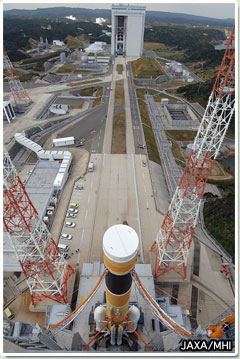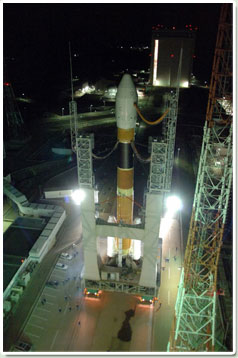 |

 |
H-IIA rockets are launched from my regular workplace, TNSC, and M-V rockets from the Uchinoura Space Center. Naturally, the H-IIA and M-V launch teams are different, but H-IIA F8 and F9, which took off within a month of each other, shared almost exactly the same staff. It was the first time we prepared for two launches concurrently, and coordinating schedules for the facilities and staff was challenging.
An H-IIA rocket is usually shipped to TNSC a month and a half before its launch date. The rocket is assembled up to the second stage at the Vehicle Assembly Building, and after inspection, it waits for its satellite, which is getting its finishing touches at the Spacecraft Test and Assembly Building. Once it is ready, the satellite is covered with a faring for protection.
The satellite is transferred to the rocket about two weeks before the launch, and is assembled with the second stage about 10 days before. After that, the rocket and satellite teams work at the same location, sometimes separately, sometimes collaboratively.
This time, we first assembled H-IIA F8 and let it stand by just before collaboration with the satellite team began, so that we could start the assembly and inspection of H-IIA F9. Then, when the payload of F8, the satellite ALOS, was ready, we stopped working on F9 and went back to F8. Preparations for the two vehicles were never conducted at the same time, but one by one. The most challenging part was scheduling staff and facilities so that the two teams could work efficiently and smoothly. In fact, it was not until sometime in late October or early November that the schedule was finalized.
Although, of course, there were nights when we stayed very late to finish that day's task, once the schedule was set, the rest went well, as all we needed to do was to follow the schedule.
Despite the fact that TNSC has the facilities to assemble and inspect two spacecraft concurrently, we had never had a chance to do so until now. Scheduling was difficult, but we were able to use the center's facilities efficiently. If there are more frequent launches in the future and quick preparation is required again, we have confirmed our ability to do so and gained confidence. |


 |
Some device problems and bad weather forced a five-day delay in the launch of H-IIA F8, which was originally scheduled to take off on January 19. Undeniably, the postponement was a momentary disappointment to the staff, but I think it was the right decision to delay the launch to ensure its success.
Light rain is not an obstacle to an H-IIA rocket launch, but lightning can damage electric devices onboard and render the rocket uncontrollable. Wind can also be a restriction factor. A rocket begins its ascent slowly; if a gust of wind hits it before it picks up speed, the rocket can shift sideways and crash into the launch tower. Weather is a major factor in rocket launches, so it is very important to have accurate forecasts at launch time.
TNSC has its own meteorologists, who are watching weather data all the time. They make their forecast using various data sent from the Japan Meteorological Agency: weather observation from, for instance, the 80-meter weather tower, and historical data. Within a one- or two-hour window, the accuracy of their forecasts is greater than 90 per cent.
The H-IIA rocket uses liquid fuel, and its tank is filled just before the launch. The fuel cannot be stored in the tank for a long period of time, because it evaporates. If the launch is postponed after the tank has been filled, the tank must be emptied, and it takes several days before it can be refilled. To avoid this kind of delay, the right decision must be made at the right time. |
|
 |


A view of F9 (front) and F8 (back), from Launch Pad 1 |


Transferring the faring, with the satellite protected inside, from the Spacecraft Test and Assembly Building to VAB |


F8 being transferred from VAB to Launch Pad 1
 |
|
 |